Decoding cryptic maps said to reveal paths to subterranean treasure vaults.
Decoding Cryptic Maps: Paths to Subterranean Treasure Vaults
Throughout history, tales of lost treasures and hidden vaults have captivated adventurers and historians alike. The idea that cryptic maps can lead to subterranean treasure vaults has inspired countless expeditions. This article will explore the significance of these maps, delve into historical examples, and provide insight into how they can be decoded.
The Historical Context of Treasure Maps
Treasure maps have long been part of folklore. From pirate legends to lost civilizations, they hint at a world filled with uncharted territories. One notable example is the famous X marks the spot on maps associated with pirates like Captain Kidd. In the late 17th century, Kidd was known for burying treasure along the East Coast of America, particularly in places like Oak Island, Nova Scotia, where treasure hunters have been searching for centuries. legend of hidden treasure has turned Oak Island into an archaeological hotspot, as indicated by the numerous expeditions documented over the years.
Understanding Cryptic Maps
Cryptic maps often contain a combination of symbols, codes, and obscured landmarks. The analysis of such maps requires a keen understanding of historical cartography, geography, and sometimes even linguistics. Common elements found in these maps include:
- Symbols and Icons: Maps may feature unique symbols representing treasures, dangers, or trails. For example, an ancient map may display a skull to indicate danger or a tree symbol to denote proximity to treasure.
- Coordinates and Landmarks: Many treasure maps refer to geographic markers that are recognizable, such as mountains, rivers, or abandoned structures.
- Textual Clues: Instructions or riddles may be inscribed on the map, requiring deciphering skills and lateral thinking.
Decoding Techniques
Decoding a cryptic map requires a systematic approach. Here are essential steps that treasure hunters can take to uncover hidden treasures:
- Research Historical Context: Understanding the era when the map was created can provide clues to its significance. For example, a map from the 18th century may reference geography that has drastically changed over time.
- Analyze Symbols: Each symbol must be carefully analyzed in relation to known cartographic practices of the time period. Mapping symbols could be derived from various cultures, thus entailing cross-cultural research.
- Field Surveys: After identifying potential treasure locations, conducting archaeological surveys can shed light on the historical accuracy of the map.
Case Study: The Treasure of the Flor de la Mar
The Flor de la Mar was a Portuguese ship that sank in 1511 off the coast of Malaysia, carrying an immense treasure. A legendary map believed to show its resting place has spurred decades of treasure hunting. The map includes cryptic symbols and references to local geography, such as the Straits of Malacca. Despite numerous attempts to locate the treasure, the Flor de la Mars bounty has yet to be recovered, illustrating the potential pitfalls of interpreting cryptic maps.
Modern Applications and Technology
With advancements in technology, modern treasure hunters are utilizing innovative tools to decode maps. Geographic Information System (GIS) technology allows for layering historical maps over current land surveys, facilitating more accurate location pinpointing. Drones equipped with imaging technology can survey vast terrain and identify possible areas of interest that correspond with the old maps.
Legal and Ethical Considerations
Before embarking on a treasure hunt, it is essential to understand the legal ramifications associated with treasure hunting. Laws vary by country and often depend on the ownership of the land and the nature of the treasure. For example, treasure trove laws in the United States state that if treasure is found on private property, the landowner often has rights to it. Ethical considerations also come into play; it is crucial to preserve archaeological sites and respect the cultural heritage of indigenous peoples when conducting searches.
Conclusion
Decoding cryptic maps that allegedly lead to subterranean treasures is both an art and a science. Historical knowledge, attention to detail, and modern technological tools can significantly enhance the process. For those intrigued by the mystery of treasure maps, understand that patience and diligence are critical. As treasure hunting continues to evolve, the thrill of unearthing hidden treasures remains an enduring allure for adventurers around the globe.
Whether youre a history buff, a treasure hunter, or simply fascinated by the stories of the past, the exploration of cryptic maps offers a gateway into worlds rich with intrigue and adventure.



